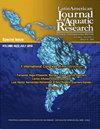不同光子通量密度和甘油浓度下杜氏藻生长过程中脂肪酸分布和产率的变化
IF 0.8
4区 农林科学
Q3 FISHERIES
Latin American Journal of Aquatic Research
Pub Date : 2022-05-01
DOI:10.3856/vol50-issue2-fulltext-2815
引用次数: 0
摘要
微藻在平稳生长阶段可以积累脂质,但关于这一阶段脂肪酸谱变化的信息很少,因此无法确定脂质含量的最佳收获时间。在F/2培养基中,以3种不同的光子通量密度(380、226和8.2 μmol photon m-2 s-1)和3种不同的甘油浓度(0、10和20 g L-1)培养杜氏藻。样品在固定阶段采取评估脂质含量和脂肪酸谱的变化。由于光照限制,380和226 μmol光子m-2 s-1时微藻生物量产量高于8.2 μmol光子m-2 s-1。在8.2 μmol光子m-2 s-1和20 g L-1甘油的作用下,第12天脂肪含量达到最大值(345.78 mg g-1),与第9天的最大值(334.16 mg g-1)相似。在不添加甘油的情况下,培养第7天多不饱和脂肪酸含量达到最大值(65.30 μg mg-1),随着时间的推移比例逐渐降低。因此,在不添加甘油的情况下,380 μmol光子m-2 s-1条件下,培养7天后,可获得最佳的脂肪酸品质。本文章由计算机程序翻译,如有差异,请以英文原文为准。
Fatty acid profile and productivity variation during the growth of Dunaliella sp. under different photon flux densities and glycerol concentrations
Microalgae can accumulate lipids during the stationary growth phase, but little information is available about fatty acid profile changes during this phase to determine the best harvesting time in respect to lipid content. In this study, Dunaliella sp. was cultured in F/2 medium at three different photon flux densities (380, 226 and 8.2 μmol photon m-2 s-1) and three different glycerol concentrations (0, 10 and 20 g L-1). Samples were taken during the stationary phase to assess lipid content and fatty acid profile variations. Microalgal biomass production was higher at 380 and 226 μmol photon m-2 s-1 than at 8.2 μmol photon m-2 s-1 in accord to light limitation. The maximum lipid content (345.78 mg g-1) was achieved at 8.2 μmol photon m-2 s-1 and 20 g L-1 glycerol at day 12, similar to that achieved at day 9 (334.16 mg g-1). The maximum polyunsaturated fatty acid amount (65.30 μg mg-1) was achieved at day 7 of culture without glycerol addition, decreasing in proportion over time. So, the best conditions and harvesting time in respect to fatty acid quality would be at 380 μmol photon m-2 s-1 without glycerol addition and after 7 days of culture.
求助全文
通过发布文献求助,成功后即可免费获取论文全文。
去求助
来源期刊

Latin American Journal of Aquatic Research
FISHERIES-MARINE & FRESHWATER BIOLOGY
CiteScore
1.70
自引率
10.00%
发文量
44
审稿时长
4-8 weeks
期刊介绍:
Latin American Journal of Aquatic Research- LAJAR is the continuation of the journal Investigaciones Marinas (1970-2007) and is published since 2008 by the Escuela de Ciencias del Mar, Facultad de Ciencias del Mar y Geografía of the Pontificia Universidad Católica de Valparaíso. LAJAR is an “Open Access” journal that publishes in English language, original research articles, reviews and short communications on aquatic science, which contain the results of research conducted in aquaculture or in oceanic and coastal marine waters of Latin America.
The following topics are considered: Physical Oceanography, Chemical Oceanography, Marine Biogeochemistry, Marine Pollution and Toxicology, Marine Geology and Geophysics, Biological Oceanography, Fisheries and Aquaculture.
 求助内容:
求助内容: 应助结果提醒方式:
应助结果提醒方式:


